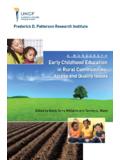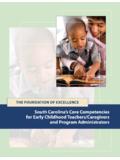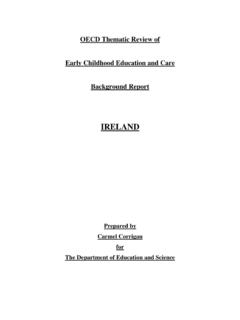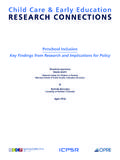Transcription of Play and Exercise in Early Years: Physically active …
1 We ve brought in logs and made places for children to sit. We ve made a mound, which we know children love running up and down. We ve created a mound in it from the earth we took out of the sandpit, and then we grassed that so they could have at least some sort of differentiation in terms of height, and being able to run up or roll down or whatever. play and Exercise in Early YearsResearch summary play and Exercise in Early Years: Physically active play in Early childhood provision Background The play and Exercise in Early Years research project was sponsored by the Department for Culture, Media and Sport (DCMS), in order to broaden the evidence base relating to Physically active play in Early childhood settings. play England commissioned the Evidence and Evaluation department at the National Children s Bureau (NCB) to carry out this project on their behalf. A review of the literature found a large body of research on the links between physical activity, health and well-being for both adults and children.
2 However there is an apparent gap in research that looks at Physically active play in Early childhood settings, or the influence that parents and practitioners have on Physically active play behaviour. Government guidance relating to Early childhood settings, including the Early Years Foundation Stagei, Fair Playii and the Children s Planiii, emphasises the importance of active learning and physical activity for children, and the need for environments, equipment and support to encourage Physically active play . This research examines children s involvement in Physically active play during Early childhood provision, and the various factors that affect children s Physically active play in the Early years. The study This was an exploratory study that consisted of observational work, semi-structured interviews with play practitioners and parents, and detailed descriptions of the physical environment in each setting. The research took place in three Early childhood settings in an inner London borough during the autumn term in 2007.
3 A total of 19 children were observed, with up to seven children selected from each of the three settings. The children were selected to give representation across two age groups: from birth to 3-years-old, and from 3- to 5-years-old. The sample was also selected to reflect the diversity of each setting in terms of gender, special education needs, ethnic origin and social background. Children s attendance patterns, for example, whether they attended part time or full time, were also taken into account. The research team spent between two and three weeks in each of the three settings. A series of 15-minute observations were carried out, totalling 130 observations overall with an average of seven observations for each child in the sample. Quantitative data was collected by recording the types of Physically active play that took place. Alongside this, qualitative data gave a description of the activity, a narrative description of the context of the activity, and post-observational reflections.
4 The role of services and parents: key findings from interviews The parents interviewed spoke about specific activities in their definitions of Physically active play , such as running or climbing, and occasionally associated it with outdoor play . Staff, on the other hand, tended to describe Physically active play in terms of types of movement, and often associated it with self-expression and exploring the world. Both parents and practitioners valued Physically active play in pre-school years for a variety reasons. These included the opportunities that Physically active play can offer for learning in a range of areas, the associated health benefits and physical development, as well as children s enjoyment and need to take part in Physically active play . The interviews suggested that neither parents or staff were risk averse , and both understood the importance of children being given the opportunity to take risks and challenge themselves during Physically active play .
5 Parents felt confident that staff would be able to manage children s safety and that staff followed procedures appropriately, which helped them to balance safety with challenges. The approach that practitioners took towards Physically active play varied across the three settings, as did the access to outdoor space available to children. Free-flow play (children being able to move freely between areas and activities), both indoor and outdoors, was prioritised in two settings, whereas the third outdoor space only offered free-flow play indoors because outdoor space was less accessible. Parents in all three settings felt satisfied with the level of Physically active play their child(ren) engaged in, and had noticed positive effects such as developing new skills, staying healthy and developing independence and autonomy. Having opportunities to be active was seen as particularly important for children who did not have a garden at home.
6 When interviewed about common physical activities they engaged in as a family, parents often talked about visits to parks or other green spaces. They said that such trips gave them the opportunity to play ball games, run or cycle for greater distances and have access to play facilities that they would not be available at home. As many of the children in the sample lived in inner city environments with limited or no access to outside space at home, this was seen as particularly important. Observing play key findings The quantitative data collected from the observations across the three settings recorded the nature and the extent of physical activity the children were engaged in. The data shows that during an average 15-minute observation, approximately eight of those minutes included some form of Physically active play . However, the proportion of observed time that included Physically active play varied across the settings from 61 per cent in one setting, to 44 per cent in another.
7 The proportion of observed time that children spent outside also varied from 41 per cent in one setting to 12 per cent in another. The research analysis therefore explored whether access to outside space, and other factors, influenced the amount and nature of Physically active play . In total, around half of the observations (65 observations) involved outdoor play at some point, but the number of minutes where children were outside was actually around a quarter. Observations showed that it was unusual for children to be outdoors without being Physically active , and play seemed to be more vigorous than when indoors. When outside, Physically active play was observed in approximately 7 out of 10 minutes, this contrasted to 4 out of 10 minutes for children whilst playing inside. For each 15-minute observation, the average child engaged in different types of Physically active play , or if we discount walking, the commonest form of physical activity.
8 Other common forms of Physically active play included running, cycling or creative play . Interaction with adults and peers during Physically active play was rare, but some observations were recorded. When there was interaction with members of staff this seemed to increase the variety and intensity of Physically active play for the younger children. There seemed to be no correlation between the amount of Physically active play and the age or gender of the child, apart from two 11-month-old children (among the youngest in the sample), who appeared to be the least active participants. Some differences in activity levels were recorded between different children, and also between the same children during different observations. The research also looked at the physical intensity of play , contrasting uninterrupted play with periods punctuated by rest, and by distinguishing walking from other activities. In doing this, the children in one setting appeared to be less active than those in the other two settings, and several children appeared noticeably less active than the rest.
9 Examining the observations of indoor play suggested that the physical layout of the settings had a substantial impact on both the type of indoor play children engaged in and how active they were. In particular, the importance of children being able to more independently and freely through the setting (free-flow) appeared to be key. All the settings had a wide range of play equipment available, both inside and outside, which was used to support Physically active play in a variety of ways. However, the findings show an average of 4 out of 10 observed minutes included active play without equipment, twice the proportion recorded with equipment. Influences on Physically active play The settings involved in the study all provided an environment where Physically active play was encouraged and supported by both practitioners and parents. There was a strong belief that Physically active play has an important role in creating learning opportunities and enabling physical development, as well as the fact that children enjoy it.
10 Just over half the observed minutes (53 per cent) included some Physically active play , indicating that most children were active for large amounts of the time whilst they were observed in the setting (although restrictions on when observations could take place for example during rest and mealtimes varied between settings). The physical environment, availability of equipment, range of activities and staff support all played key roles in facilitating and encouraging Physically active play . All settings encouraged free-flow play , but this was particularly emphasised in two of the settings as children were able to move in and outdoors as they wished. In these two settings the researchers observed children actively choosing to be outdoors during half of the observed sessions (59 and 53 per cent respectively, as opposed to 20 per cent in the setting with limited access to outside space). The researchers also observed more self-directed activity in the two nurseries with outdoor space.








